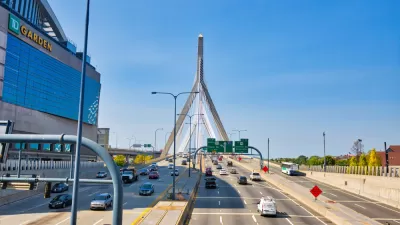Ten years after the completion of the Central Artery and Tunnel project—or the Big Dig, as it's more commonly known—has the project become more justifiable?
Anthony Flint takes a look back at the Big Dig—that infamous, long-delayed, well-over-budget project that created the most expensive highway in U.S. history.
After Flint spends a few paragraphs writing in a style close to prose poetry to describe the development process for the Central Artery and Tunnel project, we arrive to the present day—ten years after the official completion of the project. "How are we feeling now?" Flint asks. "Maybe there’s room for some grudging appreciation."
The feature length article provides background on the political and planning processes that lead up to the project before focusing on the outcomes of the project. On that latter point, Flint reports a mixed bag regarding the congestion relief pitched as a primary benefit of the project: "Looking at the new roadway system by itself, the Central Artery and Tunnel project is solving that problem [of congestion], with capacity to spare." Yet also, "[t]he theory of induced demand…has played out as predicted, particularly at the Ted Williams Tunnel, where traffic typically stacks up every evening trying to get to East Boston, Logan, and points north."
Flint also uses the perspective offered by the passage of town to analyze some of the design and execution of the project. One line sums up the analyses well: "for every triumph, there were gaffes." The article also includes evaluations about the potential transit investments that could have been funded with some of the project's $15 billion price tag as well as some of the project's benefits to the city's landscape, urban design, and development market. Flint concludes by considering whether the project could have been conceived and completed any other way.
FULL STORY: 10 years later, did the Big Dig deliver?

Alabama: Trump Terminates Settlements for Black Communities Harmed By Raw Sewage
Trump deemed the landmark civil rights agreement “illegal DEI and environmental justice policy.”

Planetizen Federal Action Tracker
A weekly monitor of how Trump’s orders and actions are impacting planners and planning in America.

How Atlanta Built 7,000 Housing Units in 3 Years
The city’s comprehensive, neighborhood-focused housing strategy focuses on identifying properties and land that can be repurposed for housing and encouraging development in underserved neighborhoods.

In Both Crashes and Crime, Public Transportation is Far Safer than Driving
Contrary to popular assumptions, public transportation has far lower crash and crime rates than automobile travel. For safer communities, improve and encourage transit travel.

Report: Zoning Reforms Should Complement Nashville’s Ambitious Transit Plan
Without reform, restrictive zoning codes will limit the impact of the city’s planned transit expansion and could exclude some of the residents who depend on transit the most.

Judge Orders Release of Frozen IRA, IIJA Funding
The decision is a victory for environmental groups who charged that freezing funds for critical infrastructure and disaster response programs caused “real and irreparable harm” to communities.
Urban Design for Planners 1: Software Tools
This six-course series explores essential urban design concepts using open source software and equips planners with the tools they need to participate fully in the urban design process.
Planning for Universal Design
Learn the tools for implementing Universal Design in planning regulations.
Jessamine County Fiscal Court
Caltrans
Institute for Housing and Urban Development Studies (IHS)
City of Grandview
Harvard GSD Executive Education
Toledo-Lucas County Plan Commissions
Salt Lake City
NYU Wagner Graduate School of Public Service




























